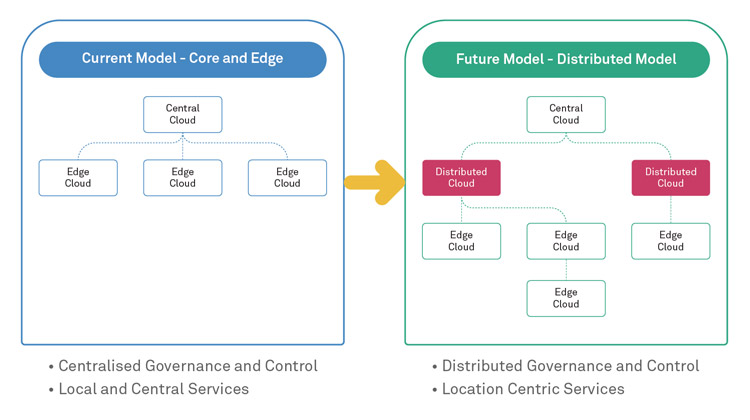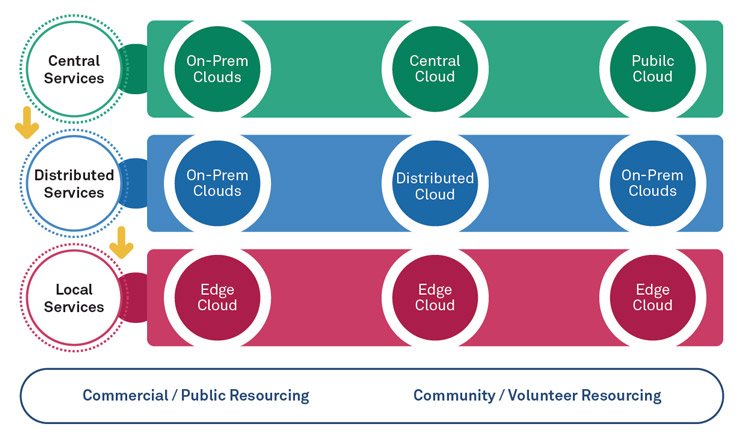Introduction
With the advancement of technology transformation, cloudification has become democratized. Cloud and Cloud Computing have become essential commodities for everyone everywhere today. Currently, cloud could be on-prem or public, and the next wave in this transformation is Edge Cloud, which seems to be gathering momentum. In the near future, both edge cloud and central cloud will definitely share equal amounts of the pie. Is this enough though? Have we reached the end state for multi-cloud or hybrid cloud with simply transitioning to central cloud and edge cloud? The answer is an emphatic NO. So what represents the next wave in this multi-cloud transformation journey? Distributed cloud could hold all the answers.
This document aims to define and socialize key aspects of distributed cloud, its importance, trajectory, benefits of adoption, and challenges.
Definition of Distributed Cloud
Distributed cloud is defined as the distribution of public cloud services to different locations outside the cloud providers’ data centers, while the originating public cloud provider assumes responsibility for the operation, governance, maintenance, and updates.
In other words, distributed cloud is one of the multi-cloud computing platforms that connects the edge with core / central clouds. This connectivity is established from a distributed set of machines in multiple locations, connecting one of the services hub or service.
One of the salient differentiators of distributed cloud is that it leverages the features and benefits of Fog computing while bridging, interconnecting Core and Edge clouds.
Distributed Cloud and its Importance
Today’s multi-cloud operandi are experiencing different levels of complexities and challenges. With the increased usage of intelligent devices such as smartphones, sensors, etc., data generation is growing exponentially. All of these new dimensions are adding more complexities, and making it harder to manage, organize, and optimize to get the best outcome from each of these devices. This is adding new challenges as well as opportunities for organizations. As a result, there is a new, evolving set of business opportunities and complexities in a true hybrid, multi-cloud model. These edge and core clouds alone do not fulfill the requirements on a larger scale with the current modus operandi, wherein most of the core services are delivered primarily from central clouds (be it hyper-scaler or On-Prem clouds). This leads to the creation of a new set of delivery models and innovations to deliver efficient, integrated services.
In order to address and offer a new mode of services in an efficient but cloudified model (without losing the control), Distributed Cloud explores and consumes core central services efficiently.
Key drivers for focus on distributed cloud are due to its uniqueness and the value proposition it brings in addition to advancements in the industry at large. Some of the drivers and developments are listed below:
Thus, Distributed Cloud brings value to cloud service providers by seamlessly leveraging the central services in a distributed manner, without compromising on control and efficiency.
Transformation Approach
Distributed cloud is going to evolve from the current set of cloud models to both Core and Edge clouds. The journey to transform the current models to meet and suit distributed cloud requirements will be long.
Central Cloud Adoption: In this model, the current hyper-scalers will redefine and tailor current services and models to become light, but retain the overall governance and control functionalities.
Service Providers Adoption: The other approach is where the service providers such as Telecommunications or hosting or system integrators or hosting providers or a combination, wherein the services are tailored and expanded to adopt a distributed model of services delivery.
Edge Cloud Providers Adoption: Since the nature of distributed cloud is closer to edge cloud providers, the latter is naturally a suitable fit to expand the portfolio of services by adopting the governance and control layer functionality to meet and align for distributed cloud. This could be achieved through a large edge cloud, be it near edge or far edge cloud sites of the current edge cloud models.

Figure 1 : Cloud Transformation Models
Execution Models
With reference the execution models, the distributed cloud are delivered in one of the two ways – Commercial or Community centric. However, it is expected additional models might emerge in due course of time with the advancement of technology and consumption pattern.

Figure 2 : Multi-Cloud Architecture Delivery Models
Key Benefits
Distributed cloud will add value across organizations with these salient benefits:
Key Challenges
The trajectory and journey for distributed cloud when compared to other cloud evolutions isn’t simple by any stretch of the imagination. This is due to the prevalence of various complexities, multiple ecosystems’ involvement, and varied levels of approval entities involved. Location is going to be the key in distributed cloud unlike other clouds. The law of the land defines some of the characteristics for distributed cloud.

Some of the key dependencies for this distributed cloud evolution and maturity would be the feasibility and compatibility of hardware abstraction layer sharing capabilities. These components include but are not limited to processors sharing, (DRAM) Dynamic Random Access Memory, and add-on components such as SSDs, GPUs, and FPUs.
Conclusion
Distributed cloud will definitely evolve over a period of time, bringing enhancements to user experience while simultaneously proving to be economical. Its evolution is based on various socio-economic and political dependencies in addition to technological advancements. This buzz around the concept of distributed cloud will be an integral part of CXO in the long run.
Distributed cloud connects the dots of edge cloud and central cloud to make the ecosystem a true multi, hybrid cloud in the future.
To know more about its unique capabilities, please contact us at sdx-cis@wipro.com
Appendix A1: Bibliography
Appendix A2: Taxonomy
Acronym |
Description |
|---|---|
API |
Application Programmable Interface |
CDN |
Content Delivery Network |
Cloud Computing |
https://en.wikipedia.org/wiki/Cloud_computing |
CPU |
Central Processing Unit |
DRAM |
Dynamic Random-Access Memory |
Edge Computing |
https://en.wikipedia.org/wiki/Edge_computing |
Fog Computing |
https://en.wikipedia.org/wiki/Fog_computing |
FPGA |
Field Programmable Gate Array |
Intel |
WWW.INTEL.COM |
IoT |
Internet of Things |
ISV |
Independent Software Vendor |
IT |
Information Technology |
NexGen |
|
NIST |
National Institute of Standards and Technology |
OEM |
Original Equipment Manufacturer |
Open source |
WWW.Opensource.Com |
PoV |
Point of View |
RA |
Reference Architecture |
RSA |
Rack Scale Architecture |
SDN |
Software Defined Network |
SDx |
Software Defined Everything |
SI |
System Integrator |
SR-IOV |
Single Root I/O Virtualization |
Telco |
Telecommunication Service Providers |
Wipro |
WWW.WIPRO.COM |
ZSM |
Zero Touch Service Management |
Rambabu Kata
Ram is an IT professional with 26 years of industry experience in IT, delivery, architecture, practice, and pre-sales. He has a Bachelor’s degree in Electronics and Communication Engineering and a Master's in Marketing Management. He can be reached at rambabu.kata@wipro.com.
Govindan Kutty
Govindan is an IT professional with 25 years of industry experience in IT delivery, solution engineering, and practice development. Govindan currently heads the solution engineering and innovation center. He can be reached at govindna.kutty@wipro.com.
Click here to download your copy of State of IT infrastructure report 2020